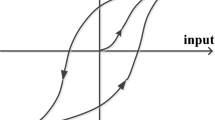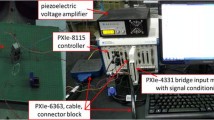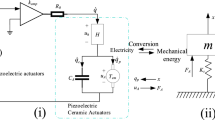Abstract
Robust and adaptive nonlinear controllers play an indispensable role in industrial applications targeting nanopositioning. Internal model control has been widely used in compensation of hysteresis, creep and vibration for piezoelectric actuators along with least-square estimator regimes. However, as real-time scenarios and presence of uncertainties, disturbances play a crucial factor in determining the efficacy of the chosen controller, a comparative analysis is very effective in this situation. This research focuses on an extensive comparative analysis of two controllers, namely, modified-internal model control (M-IMC) and recursive least-square estimator (RLSE) under several test cases. Results put forward which controller is effective under what scenario that enhances the overall precision positioning efficiency of the system.
Access provided by Autonomous University of Puebla. Download chapter PDF
Similar content being viewed by others
Keywords
1 Introduction
Piezoelectric actuators are a class of flagship actuators which has been used in micro/nano-manipulation-related industrial applications such as biological cell operator, precision engineering in PCB industry, MEMS manufacturing, space optics, etc. due to prominent advantages like precision positioning, speed of response, resistance to electromagnetic interference, high torque handling capability and high force capability in [1,2,3]. In [4] paper, adaptive feed forward control and recursive least-square estimator (RLSE) with adaptive feed forward (FF) controller are presented that performs better for parameter uncertainty of the system. The PSO and BFO-based redesigned internal model control (M-IMC) with PID controller is proposed in [5] for nonlinear piezoactuator which allows good set point tracking and disturbance rejection properties. Internal model control is one of the simplest control strategies being applied for several applications. PID-based IMC control strategy which is the most practically used controller is one of the reasons of its widespread acceptance and has hardware implementation reliability. A tuning method of IMC to control overshoot in a speed controlling system—a crucial subsystem in the hydro-electric power plant is elaborated in [6]. In this research, PSO-based M-IMC controller has improved path tracking and disturbance rejection performance compare with the classical IMC controller. Piezoactuators are widely used for precision and positioning control at micro-nanometer level in several industrial applications and have different advantages like higher accuracy, quick response, and enhanced torque. An improved PID-based IMC controller is proposed for nonlinear hysteretic piezoelectric actuator in [7] and result proved that controller performance improved over the traditional control. The piezoactuator is modeled as a second-order system by experimentally identified parameter and M-IMC controller is implemented in time delay environment approximated using first-order Padé expansion. A Smith predictor-based M-IMC is also proposed in [8] where M-IMC controller decreased overshoot and settling time of the response compared to traditional IMC and PID designs.
Contributions and problems addressed in the paper are as follows: Different controllers have been performed in MATLAB Simulink on the nonlinear piezoelectric actuator mentioned in Sect. 1.2. Presented controller has been explored by exposing the plant model to different disturbances like error comparison, parameter sensitivity test, mixed-amplitude, mixed-frequency input signal, external disturbances with set point tracking like zero path tracking with impulse disturbances (delay 1 s, sample time 20 s), zero path tracking with step input conjunction with impulse disturbances and zero set point tracking with Gaussian noise. The controller performance result suggests that controller’s performance depends upon the various application of the system.
2 RMS Error Comparison
The study has been carried using a sinusoidal wave signal as an input amplitude of 10 μm, and frequency range of signal 1 Hz which is to be followed by the piezoactuator. The RMS error of the corresponding control schemes is placed in Table 1. C1: Feed forward traditional control (FF), C2: Cascaded feed traditional forward and feed back (FF + FB), C3: Recursive least-square estimator (RLSE), C4: Modified-internal model control (M-IMC).
It is observed that order of performance of controllers is as per the following order M-IMC, RLSE, FF + FB, FF as shown in Fig. 1.
3 Parameter Sensitivity Test
As illustrated in Ref [6], the main reason for occurrence of mismatch in plant and model is accountable to the approximations while transforming a physical plant to its mathematical model. This mismatch is quite common and takes place due to several reasons like improper identification of system, or inappropriate order consideration of the system. Besides, nonlinear properties also add up to this error in approximation. The following section considers a plant model parameter mismatch of ± 2% and ± 5% in plant parameters as compared to the traditional model and the RMS errors are presented in Tables 2 and 3, respectively. It has also been observed earlier that M-IMC offers the best RMS tracking error (0.16577 nm) among the observed controllers. Accordingly, to determine the deviation from this value, Tables 2 and 3 are presented which contains the difference of the RMS errors for plant model mismatch with the M-IMC controller value. From Tables 2 and 3, it can be concluded that M-IMC and RLSE have the better compensation of the parametric uncertainty, which is followed by FF + FB and FF. The efficiency of M-IMC over RLSE is clearly seen as the parametric variation is increased to 5%
4 Performance Against External Disturbances
Transfer model of disturbances is not enough to withstand for the disturbances which is effect the plant of the system in real life environment. The external disturbance has been represented as variance of a Gaussian noise in the system, first at the input side as a process noise, and second, as a measurement noise toward the plant output. The error values of Gaussian noise in each of the controller are shown in Tables 4 and 5, respectively, and can be assessed through two metrics, a) variation induced due to the presence of the noise which is represented by a difference of maximum and minimum error value and b) deviation of the average error due to noise with the best attained tracking error of M-IMC controller is 0.16577 nm. From the table, it is observed that using the second metric, the performance of the controllers toward eliminating noise is as follows RLSE, M-IMC, FF + FB and FF. A schematic of the error plot suggesting similar controller performance is shown in Fig. 2.
4.1 Gaussian Noise as Process Noise Disturbance
See Table 4.
4.2 Gaussian Noise as Measurement Noise Disturbance
See Table 5.
5 Mixed-Amplitude, Mixed-Frequency Input Test
In this section, different input wave signals with varying amplitude and frequency have been applied to the PZA system and the correlative RMS tracking error is shown in Table 6. The amplitude of the input wave signal has been varied from 5 to 20 μm with the frequency varying from 0.25 to 1.0 Hz. An improvement in the error value is noticed with different adaptive controllers compared to feed forward and feedback control; it is also seen that for a particular amplitude, error increases with the increase in the frequency of the input.
5.1 Performance of the Controllers to Different Input Wave Signals—of Alternating Frequency and Amplitude
The piezoactuator has been subjected to different input wave signals and alteration of frequency (0.25 Hz, 0.5 Hz and 1 Hz) and alteration of amplitude (2.5 µm, 5 µm and 10 µm). For all the controllers, a common phenomenon is observed—the tracking error increases with increase in input frequency, and also with an increment in input wave signal amplitude. Among the comparison of different controllers, M-IMC is seen to offer the least error value for all frequencies, apart from 1 Hz. For input signal of frequency 1 Hz, RLSE is seen to has better performance as compared to other controllers. As seen in Table 6, it can be concluded that for a majority of input signals, the order of controller performance is as follows: M-IMC, RLSE, FF + FB and FF.
5.2 Performance Evaluation of the Controllers to a Mixed-Amplitudes, Mixed-Frequency Input Wave Signal
For a single mixed-amplitude, mixed-frequency signal of as shown in Fig. 3, the RMS tracking error has been tabulated in Table 6, in increasing order of controller effectiveness.
6 Zero Path Tracking Conjunction with Impulse Disturbances (Delay 1 s, Sample Time 20 s)
The response of the controllers to set point tracking against an impulse disturbance of width 20 s at t = 20 s is shown in Fig. 4. FF + FB control settles at 21.31 s; however, the response has a prominent undershoot (magnitude 0.27) along with presence of oscillation. The overshoot value for RLSE starts from a magnitude of 0.8 (less than one) and the response settles at 26.9 s, without any oscillation. M-IMC is noticed to have the broad settling time of 32.5 s.
7 Zero Path Tracking with Step Input Conjunction with Impulse Disturbances
Similar nature of controller performance is observed for the system when subject to step input with an impulse disturbance shown in Fig. 5. The controllers can be arranged in order of least settling time as FF + FB (presence of undershoot), RLSE and M-IMC.
8 Zero Set Point Tracking with Gaussian Noise
For a zero set point tracking of the piezoplant, it is subjected to Gaussian noise. Figure 6 shows the response of the different controllers with unity noise variance. Analyzing the response, it can be observed that the controller tracking performance with Gaussian noise can be arranged in the following order RLSE, M-IMC, FF + FB.
9 Conclusion
This study is focused on comparative analysis of two predominant classes of piezoelectric stack actuator and the results have been considered for different test cases.
Result indicates that a specific type of controller outperforms the other under certain circumstances and needs to be chosen depending upon the application. Modified IMC is observed to lend considerable improvement in performance for sinusoidal motion tracking and parametric uncertainty while RLSE shows a very good performance for disturbance rejection of external Gaussian noise, both as process and as measurement noise, and FF + FB controller has the least settling time with respect to set point tracking with impulse disturbance.
References
Lambert, P.,. Valentini, A., Lagrange, B.: Delcambre P.D design and performances of a one-degree-of-freedom guided nano-actuator. Robot. Comput. Integr. Manuf. 19, 89–98 (2003)
Hii, K.F., Vallance, R.R., Mengu, M.P.: Design, operation, and motion characteristics of a precise piezoelectric linear motor. Precis. Eng. 34, 231–241 (2010)
Shengdong, Y., Jinyu, M., Hongtao, W., Shengzheng, K.: Robust precision motion control of piezoelectric actuators using fast nonsingular terminal sliding mode with time delay estimation. Measure. Control 52, 11–19, (2019)
Shome, S.K., Mukherjee, A., Karmakar, P., Datta, U.: Adaptive Feedforward controller of piezoelectric actuator for micronano positioning” in Sadhana, Indian Academy of Science, Springer, 2018. Issue—Academy proceedings in Engineering Science, Vol. 43(10) (2018)
Shome, S.K., Jana, S., Mukherjee, A., Bhattarcharjee, P., Datta, U.: Bio inspired modified internal model control approach for improved disturbance rejection of piezo micro manipulator. Stud. Inf. Control 27, 295–306 (2018). https://doi.org/10.24846/v27i3y201805
Naik, K.A., Srikanth, P., Negi, P.: IMC tuned PID governor controller for hydro power plant with water hammer effect[J]”. Procedia Technol. 4(4) (2012)
Shome, S.K., Jana, S., Mukherjee, A., Bhattacharjee, P., Datta, U.: Improved internal model control based closed loopcontroller design for second order piezoelectric system with dead time. In: Proceedings of 2018 8th IEEE India International Conference on Power Electronics; Jaipur, India. pp. 1–6 (2010)
Shome, S., Jana, S., Mukherjee, A., Bhattarcharjee, P.: Model based control for second order piezo actuator system with hysteresis in time delay environment. Turk. J. Elec. Eng. Comp. Sci. https://doi.org/10.3906/elk-1907-28 (2019)
Author information
Authors and Affiliations
Corresponding author
Editor information
Editors and Affiliations
Rights and permissions
Copyright information
© 2022 The Author(s), under exclusive license to Springer Nature Singapore Pte Ltd.
About this chapter
Cite this chapter
Jana, S., Shome, S.K., Mukherjee, A., Bhattacharjee, P. (2022). Comparative Performance Study of Different Controllers for Nonlinear Piezoelectric Stack Actuator. In: Gu, J., Dey, R., Adhikary, N. (eds) Communication and Control for Robotic Systems. Smart Innovation, Systems and Technologies, vol 229. Springer, Singapore. https://doi.org/10.1007/978-981-16-1777-5_2
Download citation
DOI: https://doi.org/10.1007/978-981-16-1777-5_2
Published:
Publisher Name: Springer, Singapore
Print ISBN: 978-981-16-1776-8
Online ISBN: 978-981-16-1777-5
eBook Packages: EngineeringEngineering (R0)










